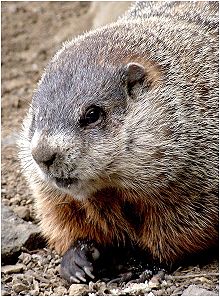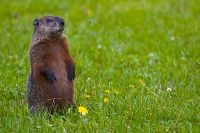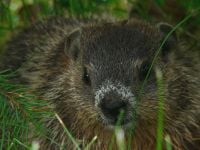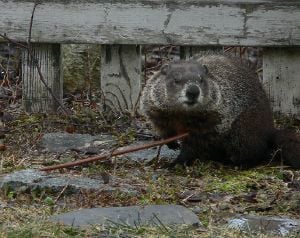Groundhog
| Groundhog | ||||||||||||||||
|---|---|---|---|---|---|---|---|---|---|---|---|---|---|---|---|---|
 | ||||||||||||||||
| Scientific classification | ||||||||||||||||
| ||||||||||||||||
| Marmota monax (Linnaeus, 1758) |
The groundhog (Marmota monax), also known as the woodchuck, or whistlepig, is a rodent of the family Sciuridae, belonging to the group of large ground squirrels known as marmots. All marmots, such as yellow-bellied and hoary marmots, live in rocky and mountainous areas, but the woodchuck is a lowland creature. It is widely distributed in North America and common in the eastern and central United States. In the west it is found only in Alaska, Alberta, British Columbia and northern Washington.
Anatomy and Behavior
The groundhog is the largest sciurid in its geographical range, typically measuring 40 to 65 cm (17 to 26 in) long (including a 15 cm tail) and weighing 2 to 4 kg. In areas with fewer natural predators and large quantities of alfalfa, groundhogs can grow to 80 cm (32 in) and 14 kg (30 lb). Groundhogs are well adapted for digging, with short but powerful limbs and curved, thick claws. The tail is only about one-fourth of body length, much shorter than that of other sciurids. Suited to their temperate habitat, groundhogs are covered with two coats of fur: a dense grey undercoat and a longer coat of banded guard hairs that gives the groundhog its distinctive "frosted" appearance.
Groundhogs can live up to six years in the wild, and ten years in captivity. Their diet consists of grasses, clover, Plantago, garden vegetables, leaves, twigs, apples, berries, and dandelion (Whitaker and Hamilton, 1998). They are not as omnivorous as many other sciurids, but will sometimes eat small animals such as insects and snails.
Groundhogs are excellent burrowers, using burrows for sleeping, rearing young, and hibernating. The Wall Street Journal quotes wildlife expert Richard Thomas as calculating that the average groundhog moves approximately 1 m³ (35 cubic feet), or 320 kg (700 pounds), of dirt when digging a burrow. Though groundhogs are the most solitary of the marmots, the same burrow may be occupied by several individuals. Groundhog burrows generally have between two and five entrances, providing groundhogs their primary means of escape from predators. Burrows are particularly large, with up to 45 feet of tunnels buried up to 5 feet underground, and can pose a serious threat to agricultural and residential development by damaging farm machinery and even undermining building foundations.[1]
Groundhogs prefer to flee from would-be predators, and usually retreat to their burrows when threatened. However, if the burrow is invaded, the groundhog will tenaciously defend itself with its two large incisors and front claws. Additionally, groundhogs are generally antagonistic and territorial among their own species, and may skirmish to establish dominance.
Common predators for groundhogs include wolves, coyotes, and large hawks and owls. Young groundhogs are often at risk for predation by snakes, which easily enter the burrow.
Outside their burrow, individuals are alert when not actively feeding. It is common to see one or more nearly-motionless individuals standing erect on their hind feet watching for danger. When alarmed, they use a high-pitched whistle to warn the rest of the colony.[2]
Usually groundhogs breed in their second year, but a small percentage may breed as yearlings. The breeding season extends from early March to middle or late April, following hibernation. A mated pair will remain in the same den throughout the 28-32 day gestation period. As birth of the young approaches in April or May, the male will leave the den. One litter is produced annually, usually containing 2-6 blind, naked and helpless young. Young groundhogs are weaned and ready to seek their own dens at five to six weeks of age.
The groundhog prefers open country and the edges of woodland, though it is rarely far from a burrow entrance. Since the clearing of forests provided it with much more suitable habitat, the groundhog population is probably higher now than it was before the arrival of European settlers in North America. Groundhogs are often hunted for sport, which tends to control their numbers. However, their ability to reproduce quickly has tended to mitigate the depopulating effects of sport hunting.[1] As a consequence, the groundhog is a familiar animal to many people in the United States and Canada.
Groundhogs raised in captivity can be socialized relatively easily; however, their aggressive nature can pose problems. Doug Schwartz, a zookeeper and groundhog trainer at the Staten Island Zoo, has been quoted as saying "They’re known for their aggression, so you’re starting from a hard place. (Their) natural impulse is to kill ’em all and let God sort ’em out. You have to work to produce the sweet and cuddly."[3]
See also
Notes
- ↑ 1.0 1.1 Jessica E. Light, Marmota monax, Animal Diversity Web, University of Michigan Museum of Zoology. Retrieved December 20, 2007.
- ↑ Woodchuck, Hinterland Who's Who, Canadian Wildlife Service. Retrieved December 20, 2007.
- ↑ Andy Newman, Grooming a Weatherman for His TV Debut, and Hoping He Doesn't Bite the Host. New York Times, January 12, 2007. Retrieved December 20, 2007.
ReferencesISBN links support NWE through referral fees
- Whitaker, John O. and Hamilton, W J. 1998. Mammals of the Eastern United States. Cornell University Press. ISBN 0801434750.
External links
All links Retrieved December 20, 2007.
Credits
New World Encyclopedia writers and editors rewrote and completed the Wikipedia article in accordance with New World Encyclopedia standards. This article abides by terms of the Creative Commons CC-by-sa 3.0 License (CC-by-sa), which may be used and disseminated with proper attribution. Credit is due under the terms of this license that can reference both the New World Encyclopedia contributors and the selfless volunteer contributors of the Wikimedia Foundation. To cite this article click here for a list of acceptable citing formats.The history of earlier contributions by wikipedians is accessible to researchers here:
The history of this article since it was imported to New World Encyclopedia:
Note: Some restrictions may apply to use of individual images which are separately licensed.



